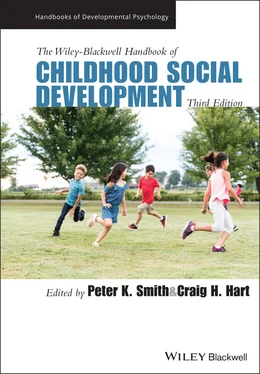Media, in all of its rapidly expanding forms, received substantial investigative attention. Early research focused on televised violence and its effects on children’s aggressive behavior. Corroboration of this effect and the pervasiveness of violence in media aimed at children (Wilson et al., 2002) spurred additional lines of investigation. Included were studies designed to explicate violent television’s role in fostering hostile attitudes and aggressive, violent, and delinquent behavior (Bushman & Huesmann, 2012). Researchers also examined media’s effects on children’s social relations, perceptions, and emotional sensitivity. Findings indicated that media use not only limited children’s participation in real‐life peer relations (e.g., friendships) and social activities (Pea et al., 2012), but it also distorted their perceptions of the social world. Illustrations included results showing that children, after viewing episodes of interpersonal conflict, developed negative expectations toward unknown peers (i.e., perceived hypothetical classmates as unfriendly; Mares et al., 2012). Additionally, evidence suggested (although see Ferguson, 2007) that violent media and video games desensitized children to violence, reduced their emotional responsiveness, and fostered stereotypes (Bushman & Huesmann, 2012).
It also became evident that media need not be harmful and in fact, could facilitate children’s social development. Research on educational and public‐service television revealed that, depending on its form and content, media could not only discourage antisocial behavior but also increase altruism. Investigators discovered, for example, that children who watched Sesame Street and Mister Rogers – TV programs rich in sociomoral and prosocial content – were more likely to learn and apply prosocial behaviors in real‐life interactions (Mares & Woodward, 2001).
The introduction of the internet (i.e., social media) and its rapid adoption by youth prompted research on its use and impact (Livingstone & Haddon, 2009). Both benefits and risks were identified. For example, whereas evidence showed that children utilized these platforms to meet and maintain friendships (Wolak et al., 2002), it also revealed that internet usage made them vulnerable to cyberbullying and abuse by predators (Ybarra et al., 2006).
Aim 2: Delineate the biological foundations, mechanisms, and processes that launch, regulate, and shape the course of social development
Theory and research on the biological foundations of human development has grown exponentially over the past few decades. Particularly noteworthy are advances in human genetics, neurological and brain development, and child temperament.
The discipline of behavioral genetics emerged during the 1960s and one of its aims was to estimate the heritability of human characteristics or behaviors. Because the human genotype could not be studied directly, genetic influence was investigated indirectly using adoption and twin studies and findings substantiated the heritability of many social characteristics (e.g., temperament, personality, aggression; Rutter, 2006).
As subsequently detailed, theoretical and investigative innovations enabled researchers to address more challenging questions (e.g., How do genetic and environmental influences combine to influence behavior? Scarr & McCartney, 1983; Rutter, 2006), but also generated controversies about the relative importance of genetic versus environmental influences. One such debate revolved around the contention that parental genes made a stronger contribution to children’s development than parenting behavior (Harris, 1995; Vandell, 2000).
As direct approaches to studying genes emerged, disciplines such as genomics and molecular genetics were formed. Innovations such as DNA sequencing techniques and the mapping of the human genome (Collins et al., 2003) made it possible to examine the association between specific genes and phenotypical social attributes.
The likelihood that multiple rather than single genes underlie observable characteristics, and the near‐infinite number of combinations thereof, complicated research on the genetic bases of social characteristics. Nonetheless, evidence began to reveal how specific genes, in combination with particular rearing conditions, were linked with children’s social development. In one such study (Caspi et al., 2002), it was discovered that the effects of parental maltreatment were moderated by children’s genetic susceptibility to that particular stressor. Children with low‐activity MAOA (monoamine oxidase A: a gene that breaks down stress‐linked neurotransmitters) tended to develop higher levels of antisocial behavior than those with high‐activity MAOA. Other findings showed that children who possessed a gene configuration linked to self‐regulation difficulties (i.e., chromosome 7 gene with short 5‐HTTPR) and experienced low‐quality parenting were more likely to develop externalizing problems (Davies & Cicchetti, 2014).
Neurological and brain development
The emergence of neuroscience as a discipline and ensuing innovations advanced knowledge about neurological and brain development during childhood. Research strategies progressed from static, circumscribed techniques, such as mapping individual neurons and electrically stimulating brain tissue (Penfield, 1961), to dynamic, encompassing modes of inquiry made possible by imaging tools such as fMRI (Functional Magnetic Resonance Imaging). These innovations, along with other scientific initiatives (e.g., the “Decade of the Brain”) furthered efforts to elucidate the interface between brain growth and children’s social development.
Research on prenatal and infant development strengthened the premise that neurological development underlies early‐emerging social abilities and, when compromised, contributes to social dysfunctions. Findings, for example, implied that infants are biologically prepared to attend and respond to caregivers and to participate in rudimentary forms of social interaction (Bornstein, 2013). In contrast, neurological impairments attributable to prenatal teratogens (e.g., cocaine, marijuana, alcohol) were linked with early‐emerging, and in some cases, lasting social and emotional difficulties (Behnke et al., 2013).
Studies of brain maturation revealed that, throughout childhood and adolescence, there were periods of rapid growth and pruning within specific brain regions (e.g., visual, motor, auditory, language centers) and progress toward hemispheric lateralization and connectedness. Growth of this type was found to be associated with improvements in infants’ and children’s social and emotional capacities, skills, and regulatory abilities (Nelson et al., 2006).
Neuroscientific findings also supported the conclusion that social experience is a necessary component of brain development. Evidence implied that, although the brain is wired to “expect” species‐wide forms of experience (i.e., experience‐expectant processes), it also is influenced by experiences that are unique to the individual (i.e., experience‐dependent processes; Shonkoff & Phillips, 2000). On this basis, it was argued that experience essentially “customizes” the child’s brain (e.g., builds, differentially strengthens, prunes neuronal networks). Support for this contention included evidence linking brain alterations with differences in children’s early experiences and rearing conditions (e.g., deprivation, isolation, abuse; Nelson et al., 2007).
Recent innovations include the construct of the “social brain” which was conceived to be a network of brain sites (Blakemore, 2008; Bornstein, 2013) that facilitated the processing and interpretation of social phenomena (e.g., recognizing faces, predicting another’s actions). It was postulated that this network, along with other brain regions, contained a “mirror” system of neurons that enabled children to empathize or “experience” the same emotions they observed in others. Imaging data provided considerable support for the existence of these networks and their hypothesized functions (Blakemore, 2008).
Читать дальше












